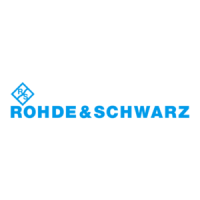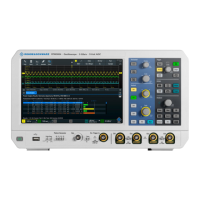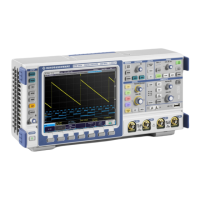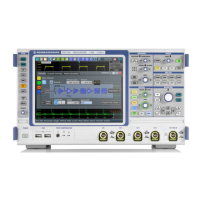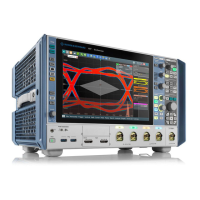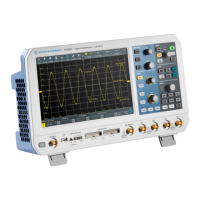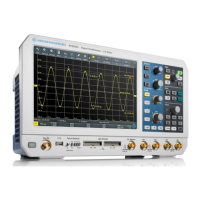Serial bus analysis
R&S
®
RTM3000
273User Manual 1335.9090.02 ─ 09
A5 =
Hex value of the 1
st
byte, with the binary value 10100101
5$ =
Hex value of the 2
nd
byte. The 1
st
nibble has the binary value 0101 and the 2
nd
nibble is repre-
sented by the "$" character, as it includes one "X" bit (don't care)
XX (gray) =
The 3
rd
byte is not contained in the specified pattern
I2C Trigger.................................................................................................................. 273
Slave Address.............................................................................................................273
Symbolic ID.................................................................................................................274
Data condition............................................................................................................. 274
└ Byte Offset.................................................................................................... 274
└ Number of Bytes........................................................................................... 274
└ Data: Bin / Hex pattern..................................................................................274
I2C Trigger
Selects the trigger condition.
"Start"
Sets the trigger to the start of the message. The start condition is a
falling slope on SDA while SCL is high.
"Stop"
Sets the trigger to the end of the message. The stop condition is a ris-
ing slope on SDA while SCL is high.
"Restart"
Sets the trigger to a repeated start - when the start condition occurs
without previous stop condition. This can happen when a master
sends multiple messages without releasing the bus.
"No Ack (Miss-
ing Ack)"
Missing acknowledgement: the instrument triggers, if the slave does
not send the acknowledge bit. Acknowledging takes place after every
byte. If the transfer failed, at the moment of the acknowledge bit, the
SDA line is on high level during the high period of the clock pulse.
"Address and
Data"
Sets the trigger to an address or data pattern, or a combination of
both.
See "Slave Address" on page 273 and "Data condition" on page 274.
Remote command:
TRIGger:A:I2C:MODE on page 620
Slave Address
Sets the slave address to be triggered on. If you want to trigger only on a data pattern
and the address is not relevant, enable "Any Address".
To specify the slave address, set the following properties:
●
Set the length of the slave address: "7Bit" or "10Bit".
●
Toggle the trigger condition between "Read" and "Write" access of the master. The
read/write bit is the 8
th
bit of the first address byte of a frame.
●
Set the address of the slave device: enter the binary or hexadecimal address
value. You need an exact address, "X" bits (don't care) are not allowed.
Remote command:
TRIGger:A:I2C:AMODe on page 621
TRIGger:A:I2C:ACCess on page 620
TRIGger:A:I2C:ADDRess on page 621
I²C (option R&S
RTM-K1)
